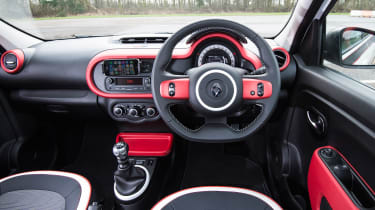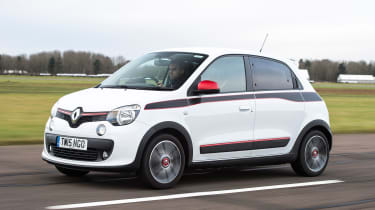Renault Twingo (2007-2014) review - Engines, performance and drive
The Twingo is agile in town but not much fun on faster roads; driver engagement is limited and refinement poor
Thanks to its rear-engined, rear-wheel-drive layout, the Twingo is a tantalising prospect as a driver’s car. However, the arrangement has more to do with practicality and packaging than driving dynamics.
If you were expecting a city car with the agility of a Porsche 911, you’ll be disappointed, but positioning the drivetrain at the back has some advantages. It enables the Twingo's front wheels to turn through 45 degrees, giving it a class-leading turning circle of just 8.6 metres. Around town, you can make turns that only a London taxi or a Toyota iQ can rival.
Parking the Twingo is a breeze, too, while the seating position really helps visibility – you sit higher up in the Renault than you do in most of its city car rivals. The elevated position is perfect for making the most of the tight turns and manoeuvring in and out of tight spaces.
The variable-rate steering means the wheel is light and easy to turn at low speed, boosting manoeuvrability. The steering does weight up as you gain speed, but the set-up is far from perfect. It makes the Renault seem unnatural and vague in corners, whereas rivals like the Skoda Citigo respond more keenly to your inputs.
More reviews
Car group tests
- Skoda Citigo vs Kia Picanto vs Renault Twingo
- Suzuki Ignis vs Renault Twingo
- Kia Picanto vs Renault Twingo & Hyundai i10
- Smart ForFour vs Renault Twingo and SEAT Mii
In-depth reviews
Long-term tests
Road tests
Used car tests
No matter which model you go for, the Twingo is a fairly comfortable car. The suspension deals well enough with bumps, potholes and speed humps, although it can get a bit fidgety over rough surfaces at lower speeds, so the car never feels quite as polished as the Hyundai i10, for example. The ride gets better at speed, although there's quite a bit of wind noise from the A-pillars, which spoils the enjoyment a little.
In the Twingo GT, the very short overhangs mean it's keen to turn in, but the light, quick steering, narrow track and tall body promotes a noticeable level of roll. Renault says it’s also recalibrated the ESC for a sportier feel, but the Twingo’s stability control still feels restrictive in an effort to mask some of the chassis’s natural traits – there’s not a great sense that the car is rear-wheel drive, and the electronics keep the rear end in check on the road.
On standard 17-inch alloys the GT's ride is firm, and the stiffer chassis feels crashy over pocked roads. The GT is bouncy at speed as a result and it thumps over bumps at lower speed in town, too, but it still remains fun to drive. Overall, if you're looking for a sporty option in the city car class, then the VW up! GTI runs rings around the Twingo GT to the extent that it's redefined the small performance car brief.
Engines
Twingo buyers have a choice of three-cylinder petrol engines: a 1.0-litre with 69bhp which claims 0-62mph in 14.5 seconds and an 89bhp turbocharged 0.9-litre that promises a time of 10.8 seconds. The more powerful 99bhp version of the same engine only appears in the Twingo GT, which is no longer available new. All versions come with a five-speed manual gearbox as standard, although the 89bhp turbo is available with a six-speed EDC automatic as an option on some versions.
If you plan to do plenty of motorway journeys, the more punchy turbo will be the better bet. If not, the lower-powered engine is the nicer car to drive in town.
Even the turbocharged Twingo doesn't enjoy the 'big car' feel of a Skoda Citigo or its SEAT Mii and Volkswagen up! sister cars. The VW Group trio also ride better and deliver far more mature body control, plus they are considerably quieter at speed – although they don’t have the character of the Twingo.
Despite its lacklustre performance figures, the lower-powered car is nippy enough around town, which is primarily where it was designed to be used. It even feels more responsive than the turbo, which is a bit sluggish off the mark until the boost kicks in.
When revved hard, the more powerful engine is noisier than the naturally aspirated 1.0-litre, and the turbo whine can be unpleasant at very high engine speeds. The two versions of the Twingo deliver similar economy.
In the Twingo GT, the revised engine mapping doesn’t make the power delivery feel very linear. Squeeze the throttle in second, and the Twingo climbs on boost as the turbo wakes up, accelerating at a faster rate than you might have expected. However, the remainder of the throttle travel doesn’t have quite the same effect – the engine gives more of its performance at the top of the pedal’s travel.
However, it’s a surprisingly quick little car. The 898cc turbo triple serves up 108bhp and an impressive 170Nm of torque, which given the car only weighs 1,001kg meant the GT accelerated from 0-60mph in 9.6 seconds when we tested it. This was four tenths faster than the VW up! TSI, but four-tenths slower than a Smart ForTwo Brabus. In-gear between 30-50mph the Twingo matched the ForTwo, taking 3.7 and 5.1 seconds in third and fourth respectively. However, the gearshift isn’t as precise as a VW up’s, with a more indistinct feeling when it comes to slotting the ratios.






